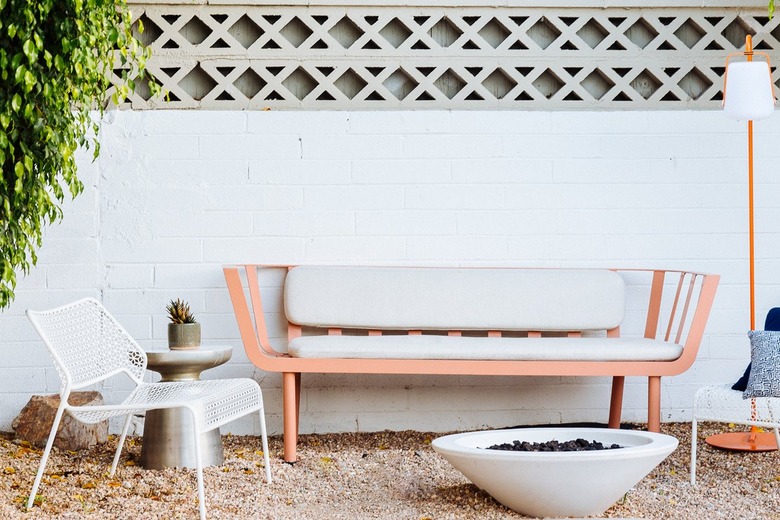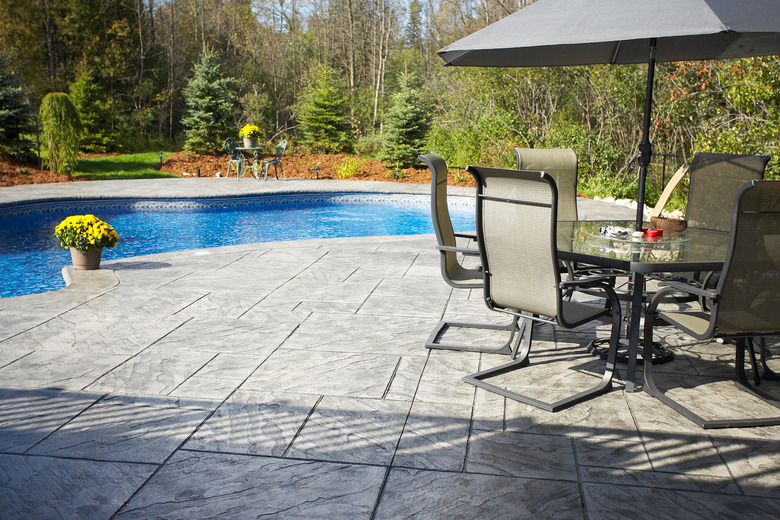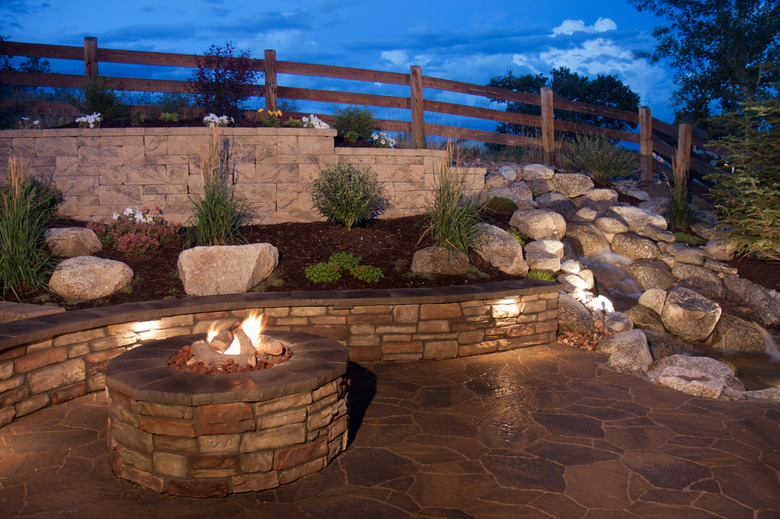The 5 Best DIY Patio Materials
When planning a new patio, the choice of patio material is as important as the size of the patio and its place in the landscape, and you'll have several factors to consider. Cost and appearance are usually at the top of the list, of course, but durability is also important, and if you're planning to do the project yourself, you'll also want to know about ease of installation. Setting concrete pavers in sand is much more DIY-friendly than pouring a concrete slab, for example, and some materials, such as flagstone, call for skill levels and professional tools that the average DIYer might not possess.
Some homeowners have tastes that tend toward the offbeat and may want to make a patio out of wood or rubber. Most, however, will probably prefer to stick with five materials proven for durability and usability: gravel, poured concrete, concrete pavers, brick pavers and natural stone, which are listed in order from lowest to highest cost and from least to most sophisticated. Consider the pros and cons of these five options to help design the patio that will best complement your landscape and provide a restful outdoor living space for many years to come.
Gravel: The Budget Patio Material
At about $6 to $10 per square foot, gravel is a low-cost option that is more stylish than it sounds. Gravel patios and walkways are staples in English gardens, semiwoodland landscaping themes, and they look their best in xeriscape landscape settings. You are also starting to see gravel patios pop up in the backyards of sleek, mid-century modern homes, proving that the low cost of material doesn't mean you have to sacrifice on style.
Best of all, installation calls for little more than construction of a border to keep the gravel in place; a dug-out, tamped base; and a truckload of gravel. Pea gravel, which consists of smooth pebbles about the size of peas, is the most common type of gravel for a patio, but you can also use angular rock that locks together better, although it's less comfortable to walk on and is not as decorative. Lava rock and quartzite are also options.
One drawback of a gravel patio is the instability of the surface, which can make it difficult to place tables, chairs and other furniture and complicates snow shoveling in winter. Gravel tends to get displaced by foot traffic, and a significant amount inevitably ends up outside the patio boundary and scattered across the yard. If you're willing to top off the gravel periodically and rake it around to discourage weeds, however, a gravel patio can virtually last forever.
Concrete Offers Flexible Design Options
If you picture a gray slab when you think of a concrete patio, you haven't done enough research. Concrete can be stained, dyed and stamped to resemble stone pavers, wood planks or anything else your imagination can envision. Add pea gravel as aggregate to the concrete mixture and you can even have a solid-surface gravel patio. The base cost for pouring a concrete slab is between $6 and $13 per square foot, but expect to pay extra for staining, stamping and sealing.
Concrete is one of the most popular types of outdoor patio, but installing one isn't really a DIY project. To be properly protected from cracking, the concrete must be reinforced with steel bars, and decorative touches such as stamping and staining should be added by someone who has done it before because you only get one chance. Even a professionally installed concrete patio is vulnerable to cracking as the ground shifts, and when cracking is severe, the patio has to be replaced. You can enjoy the patio for at least 20 to 30 years before that happens, though.
Landscaping With Concrete Pavers
Concrete pavers offer the look of concrete without the risk of having to replace the entire patio if a major crack develops. When a concrete paver cracks, it's a fairly easy job to dig it out and replace it. That's one advantage of concrete pavers, and there are others, not the least being that installation is a project you can do yourself. Even if you do it yourself, though, you'll pay $7 to $20 per square foot for the pavers, which is considerably more than it costs to pour concrete.
Another advantage of concrete pavers over solid concrete is that they provide better drainage. The pavers are typically set on a bed of sand, and the gaps between them are also filled in with sand, so water passes through easily, and puddles that freeze over in the winter and create slipping hazards are seldom a problem. Maintenance requires little more than sweeping and the occasional power wash, so it's a breeze, especially if the pavers have been sealed, which is recommended. Because pavers are available in several colors and sizes, they can be the raw material for a variety of patio ideas and designs.
For a compromise between a monolithic concrete slab and bricklike concrete pavers, large concrete pavers have become popular with DIYers. Large pavers can be anything from about 2 feet square to larger rectangular shapes. They have a modern look and can be purchased precast or can be poured in place like small concrete slabs. Large pavers are typically set with sizable gaps between them, which can be filled with grass, ground-cover plants or decorative gravel.
A New Patio With Old Bricks
You don't have to use old bricks as a patio material; new ones will work just fine, but recycling can reduce the cost of installing a brick patio, which is typically between $14 and $20 per square foot, and old bricks give your patio a weathered look that will take new bricks several years to develop. Like concrete pavers, bricks form a semipermeable, well-draining surface when set in sand, although you can also set them in mortar. Whether you use new bricks or old and set them in sand or mortar, your patio will probably last upward of 100 years.
Brick patio installation can be a DIY project if you lay the bricks in a simple end-to-end pattern, but if you want to get creative and lay a herringbone or pinwheel pattern, you're better off hiring a pro or at least consulting with one. It takes experience to get eye-catching straight lines when laying complex patterns. Professional installation costs a bit more, but you're creating a patio that could potentially exist for generations, so a little bit extra up front is worth it.
A Top-of-the-Line Stone Patio
A new patio made out of flagstone, bluestone or any other natural stone is a luxury addition to your property, and it comes with a luxury price tag that can be anywhere from $14 to $28 per square foot. That doesn't include professional installation, which is recommended for natural stone patios because of the weight of the pavers and their irregular shapes and thicknesses. DIY installation is advised only if you like a challenge, but if you do — and you have someone to help with the heavy lifting — you'll find the process akin to putting together a jigsaw puzzle.
Natural stone is the longest-lasting patio material of all, especially if the patio is set in sand. When stone pavers are set in mortar, the mortar typically fails before the stones do — if they do — but sand is a forgiving material that you can top off whenever needed. Sand joints are water-permeable and allow weeds to grow, so besides sweeping and washing occasionally, maintenance includes keeping unwanted plant growth under control. You might get lucky, though, and find moss growing on the shaded perimeters of the patio. As long as it doesn't create a slipping hazard, you might want to protect that bit of serendipitous greenery as the elegant bit of garden art it is.


